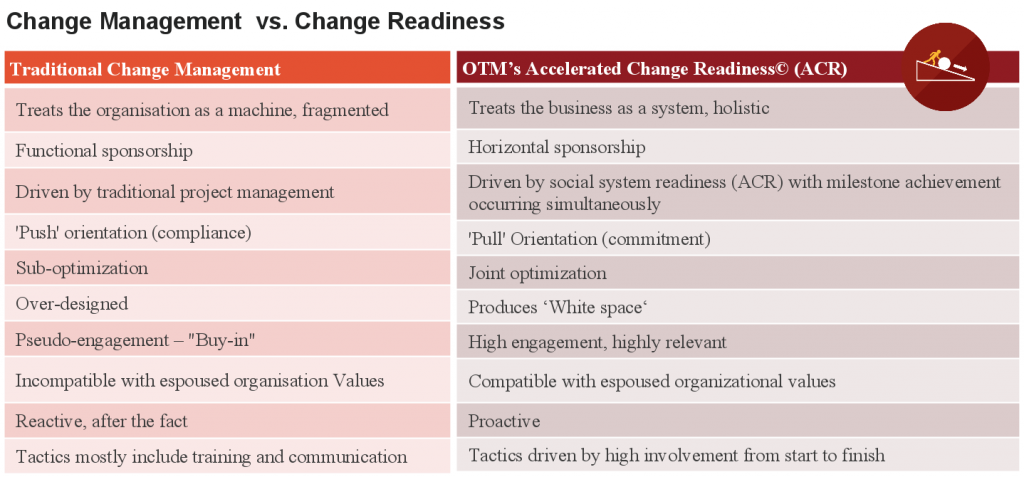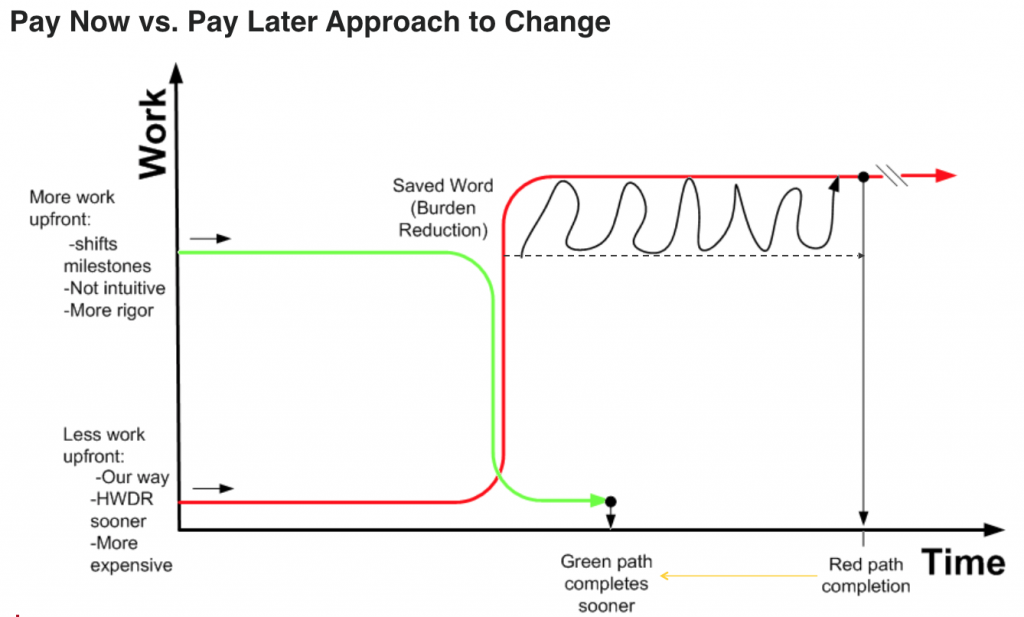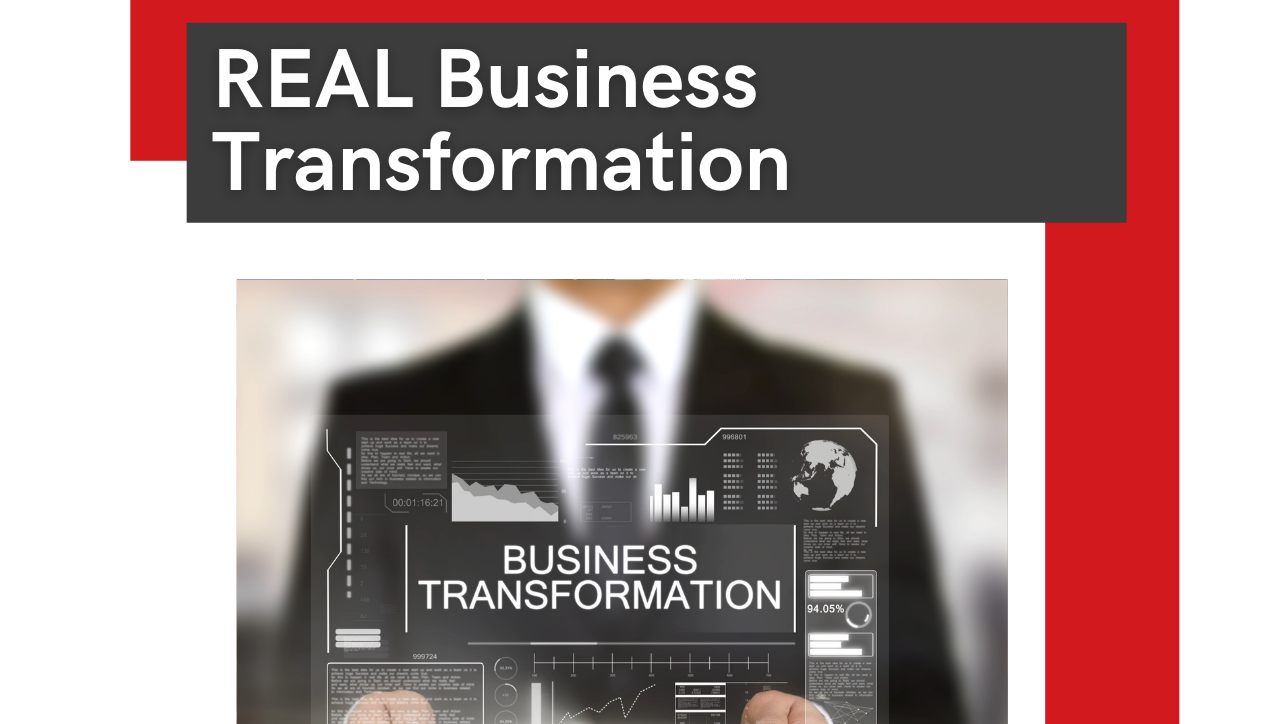5 Minute Read
Takeaway: Traditional change management is dead. In order to create true business transformations that last, you need to embrace change readiness.
REAL Business Transformation: When HOW is more Important Than WHAT.
So, you’ve decided to transform your business. Now what? The next big decision is how to go about doing it. Leaders often miss this decision because they rarely know they have a choice — a critically important choice that has enduring and significant consequences. This choice is often kept opaque due to the fact that consulting firms, especially the tech firms, have made an entire cottage industry out of “change management.”
Change management is dead.
When leaders think of any change initiative, they default to employing change management to help with the change. Coined by Conner in 1993, the term change management is a solution based on remedial, compliance-driven change. It’s employed after-the-fact, leveraging one-way communications, training and other remedial, compliance tactics usually in the support of generating “buy-in” – a term that should be eradicated from any leader’s vernacular. What “buy-in” really means is we’ve decided on the change, so now we will “tell” you into submission. At OTM, we call this “pushing” change onto the business.
Instead, Think Readiness!
Accelerated Change Readiness©, that is. Coined by ON THE MARK (M. LaScola, C. Murphy, L Kunz and P Moraga) in 1999, ACR is about real engagement of your people to architect the change so that any change is doing two three things at once: solving real business challenges, engaging the hearts and minds of your people and sustaining the change for the long term with significantly faster implementation. This is akin to “pulling the change” into the business.

It’s a “Pay Now versus Pay Later” Decision.
In summary, look at it as “push” vs “pull” or compliance-based vs commitment based change. The former will get you speed up-front, less quality solutions, significantly more effort, slower implementation complete with starts/stops and histrionics. Plus, compliance-driven change will further disengage your people from your business. The neuro-science and business evidence is compellingly clear. Compliance-based change will cost you more money, cause greater negative consequences and disengagement of your people, cause slower implementation and substantially delay the ROI of that change.

You know the saying, “your people are your most important asset?” Well, here’s your chance to put it into action. So let’s take a closer look at four readiness features and what it can deliver for you:
Pay later, it’s worth it.
This is where leaders decide requirements and parameters, and you engage your staff, usually via solution teams, to develop the solutions. While this takes more time up front and requires more effort from you and your people, think about it… who knows your business better than your staff and who ultimately has to implement?! This upfront investment allows your people to “own the change” and see it through to completion without acting as a parent.
Get better quality solutions.
Think of a jigsaw puzzle… no one person in a business sees the entire problem or knows the entire solution. Employ puzzle learning. Bring together a diverse group of staff from across the business who experience a problem or issue from their own unique perspective. Together they’ll see the entire scope of a problem, not just one view.
STOP all the nonsensical, peripheral engagement activities.
It wastes time, money and effort. Alternatively, invest all of those resources into asking your own people to use their collective brilliance to solve real business issues. Create the space for them to do it. Provide them the resources to support their efforts and get out of the way. Watch what happens to your employee engagement scores. One of the things that we see happening in all our projects is the engagement scores go through the ceiling in a positive way. The improvements and the bumps they get from that are quite significant.
Employ a disciplined, step-by-step approach complete with stakeholder reviews and approval gates.
This facilitates teams to complete focused work without getting ahead of themselves, wasting time and effort on solutions not supported. It enables the engagement of stakeholders in-between major milestones go gain their support and gather critical feedback – not to mention prepare them for any change impacts. Finally, doing this ensures leaders review and approve changes and add support to the teams along the way… sometimes referred to rolling decision process.
Leverage the 10/20/70 model of development for your people simultaneously.
Learning professionals know that the best development and learning opportunities is on-the-job – where your staff gain real experience. While classroom and online learning has its place (10%), the real gains are made through real experience. Involving your own people in to developing and implementing a solution will do more for their self-worth and development than anything you can think of… it speaks volumes to them in terms of your belief and trust in them.
So, if you want to truly transform your business, look internal for the solution and be prepared to lead.
A simple case-in-point: Nespresso UK was a perfect example of this approach in action. Its UK team was preparing to move to a new office space. In a culture where even a ten-minute longer commute can be a deal-breaker for staff, the Nespresso leadership wanted as smooth a process as possible. So, they brought the entire team into the process with the support of OTM, providing them autonomy within parameters to learn, introduce and manage the new journey and make elements of the space their own. By the time the actual move occurred, teams were itching to experience the space that they had made their own.
Inviting employees into any change process (technology, change in operating model, etc.) doesn’t have to be messy or chaotic… just the opposite, in fact. It does require a different delivery model by any consultants you choose to use and bold leadership on behalf of your leaders. This is by far the best way to ensure the quickest business transformation strategy. Give teams the opportunity to invest themselves in the business’s future, and they’ll be thankful for it for years to come.
More resources on organization design and business transformation:
- Check out this deep-diving infographic.
- Learn why organization architecture is only part of the picture.
On The Mark’s experience and passion for collaborative business transformation that’s supported by pragmatism, systems thinking, and a belief in people is unparalleled. OTM has been in business for 33 years and is a global leader in organization design consulting.


